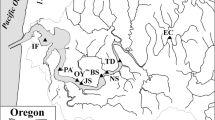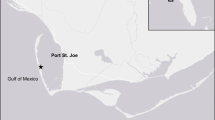Abstract
Denitrification efficiency [DE; (N2 − N/(DIN + N2 − N) × 100%)] as an indicator of change associated with nutrient over-enrichment was evaluated for 22 shallow coastal ecosystems in Australia. The rate of carbon decomposition (which can be considered a proxy for carbon loading) is an important control on the efficiency with which coastal sediments in depositional mud basins with low water column nitrate concentrations recycle nitrogen as N2. The relationship between DE and carbon loading is due to changes in carbon and nitrate (NO3) supply associated with sediment biocomplexity. At the DE optimum (500–1,000 μmol m−2 h−1), there is an overlap of aerobic and anaerobic respiration zones (caused primarily by the existence of anaerobic micro-niches within the oxic zone, and oxidized burrow structures penetrating into the anaerobic zone), which enhances denitrification by improving both the organic carbon and nitrate supply to denitrifiers. On either side of the DE optimum zone, there is a reduction in denitrification sites as the sediment loses its three-dimensional complexity. At low organic carbon loadings, a thick oxic zone with low macrofauna biomass exists, resulting in limited anoxic sites for denitrification, and at high carbon loadings, there is a thick anoxic zone and a resultant lack of oxygen for nitrification and associated NO3 production. We propose a trophic scheme for defining critical (sustainable) carbon loading rates and possible thresholds for shallow coastal ecosystems based on the relationship between denitrification efficiency and carbon loading for 17 of the 22 Australian coastal ecosystems. The denitrification efficiency “optimum” occurs between carbon loadings of about 50 and 100 g C m−2 year−1. Coastal managers can use this simple trophic scheme to classify the current state of their shallow coastal ecosystems and for determining what carbon loading rate is necessary to achieve any future state.





Similar content being viewed by others
References
Berelson, W. M., D. Heggie, A. Longmore, T. Kilgore, G. Nickolson & G. Skyring, 1998. Benthic nutrient recycling in Port Phillip Bay, Australia. Estuarine, Coastal and Shelf Science 46: 917–934.
Blackburn, T. H. & N. D. Blackburn, 1993. Rates of microbial processes in sediments. Philosophical Transactions of the Royal Society of London 344: 49–58.
Booij, K., W. Helder & B. Sundby, 1991. Rapid redistribution of oxygen in a sandy sediment induced by changes in the flow velocity of the overlying water. Netherlands Journal of Sea Research 28: 149–165.
Caffrey, J. M., N. P. Sloth, H. F. Kasper & T. H. Blackburn, 1993. Effect of organic loading on nitrification and denitrification in a marine sediment microcosm. FEMS Microbiology and Ecology 12: 159–167.
Christensen, P. B., S. Rysgaard, N. P. Sloth, T. Dalsgaard & S. Schwaerter, 2000. Sediment mineralisation, nutrient fluxes, denitrification and dissimilatory nitrate reduction to ammonium in an estuarine fjord with sea cage trout farms. Aquatic Microbiology Ecology 21: 73–84.
Cloern, J. E., 2001. Our evolving conceptual model of the coastal eutrophication problem. Marine Ecology Progress Series 210: 223–253.
Cook, P. L. M., B. D. Eyre, R. Leeming & E. C. V. Butler, 2004. Benthic fluxes of nitrogen in the tidal reaches of a turbid, high nitrate subtropical river. Estuarine, Coastal and Shelf Science 59: 675–685.
Eyre, B. D. & A. J. P. Ferguson, 2002. Comparison of carbon production and decomposition, benthic nutrient fluxes and denitrification in seagrass, phytoplankton, benthic microalgal and macroalgal dominated warm temperate Australian lagoons. Marine Ecology Progress Series 229: 43–59.
Eyre, B. D. & A. J. P. Ferguson, 2005. Benthic metabolism and nitrogen cycling in a sub-tropical east Australian estuary (Brunswick): temporal variability and controlling factors. Limnology and Oceanography 50: 81–96.
Eyre, B. D. & A. J. P. Ferguson, 2006. Impact of a flood event on benthic and pelagic coupling in a sub-tropical east Australian estuary (Brunswick). Estuarine, Coastal and Shelf Science 66: 111–122.
Eyre, B. D., R. N. Glud & N. Pattern, 2008. Coral mass spawning—a natural large-scale nutrient enrichment experiment. Limnology and Oceanography 53: 997–1013.
Ferguson, A. J. P. & B. D. Eyre, 2007. Seasonal discrepancies in denitrification measured by isotope pairing and N2: Ar techniques. Marine Ecology Progress Series 350: 19–27.
Ferguson, A. J. P., B. D. Eyre, A. Webb & D. Maher, 2004. Sediment biogeochemistry. In Pimpama River Estuary Ecological Study: Chapter 11. Report Prepared for Gold Coast Water, SKM, Brisbane.
Ferguson, A. J. P., B. D. Eyre, J. Gay, N. Emtage & L. Brooks, 2007. Benthic metabolism and nitrogen cycling in a sub-tropical embayment: spatial and seasonal variability and controlling factors. Aquatic Microbial Ecology 48: 175–195.
Frederiksen, M. S. & R. N. Glud, 2006. Oxygen dynamics in the rhizosphere of Zostera marina: a two dimensional planar optode study. Limnology and Oceanography 51: 1072–1083.
Gilbert, F., P. Souchu, M. Bianchi & P. Bonin, 1997. Influence of shellfish farming activities on nitrification, nitrate reduction to ammonium and denitrification at the water-sediment interface of the Thau lagoon, France. Marine Ecology Progress Series 151: 143–153.
Glud, R. N., 2008. Oxygen dynamics of marine sediments. Marine Biology Research 4: 243–289.
Glud, R. N., B. D. Eyre & N. Pattern, 2008. Biogeochemical responses to coral mass-spawning on the Great Barrier Reef: effects on respiration and primary production. Limnology and Oceanography 53: 1014–1024.
Gray, J. S., R. S. Wu & Y. Y. Or, 2002. Effects of hypoxia and organic enrichment on the coastal marine environment. Marine Ecology Progress Series 238: 249–279.
Harris, P. T. & A. D. Heap, 2003. Environmental management of clastic coastal depositional environments: inferences from an Australian geomorphic database. Ocean and Coastal Management 46: 457–478.
Herman, P. M. J., J. J. Middleburg, J. Van De Koppel & C. H. R. Heip, 1999. Ecology and estuarine macrobenthos. Advances in Ecological Research 29: 195–240.
Joye, S. B. & J. T. Hollibaugh, 1995. Influence of sulfide inhibition of nitrification on nitrogen regeneration in sediments. Science 270: 623–625.
Kaspar, H. F., G. H. Hall & A. J. Holland, 1988. Effects of sea cage salmon farming on sediment nitrification and dissimilatory nitrate reduction. Aquaculture 70: 333–334.
Kemp, W. M., P. Sampou, J. Caffery & M. Mayer, 1990. Ammonium recycling versus denitrification in Chesapeake Bay sediments. Limnology and Oceanography 35: 1545–1563.
Kemp, W. M., W. R. Boynton, J. E. Adolf, D. F. Boesch, W. C. Boicourt, G. Brush, J. C. Cornwell, T. R. Fisher, P. M. Glibert, J. D. Hagy, L. M. Harding, E. D. Houde, D. G. Kimmel, W. D. Miller, R. I. E. Newell, M. R. Roman, E. M. Smith & J. C. Stevenson, 2005. Eutrophication of Chesapeake Bay: historical trends and ecological interactions. Marine Ecology Progress Series 303: 1–29.
Kristensen, E., 2000. Organic matter diagenesis at the oxic/anoxic interface in coastal marine sediments, with emphasis on the role of burrowing animals. Hydrobiologia 426: 1–24.
Middelburg, J. J., K. Soetaert & P. M. J. Herman, 1996. Evaluation of the nitrogen isotope-pairing method for measuring benthic denitrification: a simulation analysis. Limnology and Oceanography 41: 1839–1844.
Murray, A. & J. Parslow, 1997. Port Phillip Bay Integrated Model: Final Report. Port Phillip Bay Environmental Study Technical Report No. 44, CSIRO, Canberra.
Nielsen, S. L., K. Sand-Jensen, J. Borum & O. Geertz-Hansen, 2002. Phytoplankton, nutrients and transparency in Danish coastal waters. Estuaries 25: 930–937.
Nixon, S. W., 1995. Coastal marine eutrophication: a definition, social causes, and future concerns. Ophelia 41: 199–219.
Risgaard-Petersen, N., 2003. Coupled- nitrification-denitrification in autotrophic and heterotrophic estuarine sediments: on the influence of benthic microalgae. Limnology and Oceanography 48: 93–105.
Short, F. T. & S. Wyllie-Echeverria, 1996. Natural and human-induced disturbance of seagrass. Environmental Conservation 23: 17–27.
Sloth, N. P., H. Blackburn, L. S. Hansen, N. Risgaard-Petersen & B. A. Lomstein, 1995. Nitrogen cycling in sediment with different organic loading. Marine Ecology Progress Series 116: 163–170.
Webster, I., 2001. Modelling denitrification in aquatic sediments. In Hart, B. T. & M. R. Grace (eds), Nitrogen Workshop 2000: Sources, Transformations, Effects and Management of Nitrogen in Freshwater Ecosystems. Land and Water Australia Occasional Paper 10/00: 109–113.
Acknowledgements
We thank the many people (too many to name) who helped with the field work and Iain Alexander and Lyndon Brooks for assistance with the data analysis. The manuscript was improved by the comments of two anonymous reviewers. This work was funded by two ARC Discovery Grants (A00000938; DP0342956) and an ARC Linkage Grant (LP0212075).
Author information
Authors and Affiliations
Corresponding author
Additional information
Guest editors: J. H. Andersen & D. J. Conley
Eutrophication in Coastal Ecosystems: Selected papers from the Second International Symposium on Research and Management of Eutrophication in Coastal Ecosystems, 20–23 June 2006, Nyborg, Denmark
Rights and permissions
About this article
Cite this article
Eyre, B.D., Ferguson, A.J.P. Denitrification efficiency for defining critical loads of carbon in shallow coastal ecosystems. Hydrobiologia 629, 137–146 (2009). https://doi.org/10.1007/s10750-009-9765-1
Published:
Issue Date:
DOI: https://doi.org/10.1007/s10750-009-9765-1




